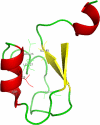Murein and pseudomurein cell wall binding domains of bacteria and archaea--a comparative view
- PMID: 22012341
- PMCID: PMC3210951
- DOI: 10.1007/s00253-011-3637-0
Murein and pseudomurein cell wall binding domains of bacteria and archaea--a comparative view
Abstract
The cell wall, a major barrier protecting cells from their environment, is an essential compartment of both bacteria and archaea. It protects the organism from internal turgor pressure and gives a defined shape to the cell. The cell wall serves also as an anchoring surface for various proteins and acts as an adhesion platform for bacteriophages. The walls of bacteria and archaea are mostly composed of murein and pseudomurein, respectively. Cell wall binding domains play a crucial role in the non-covalent attachment of proteins to cell walls. Here, we give an overview of the similarities and differences in the biochemical and functional properties of the two major murein and pseudomurein cell wall binding domains, i.e., the Lysin Motif (LysM) domain (Pfam PF01476) and the pseudomurein binding (PMB) domain (Pfam PF09373) of bacteria and archaea, respectively.
Figures


Similar articles
-
A genetically engineered protein domain binding to bacterial murein, archaeal pseudomurein, and fungal chitin cell wall material.Appl Microbiol Biotechnol. 2012 Nov;96(3):729-37. doi: 10.1007/s00253-012-3871-0. Epub 2012 Jan 20. Appl Microbiol Biotechnol. 2012. PMID: 22262228 Free PMC article.
-
Determinants of murein hydrolase targeting to cross-wall of Staphylococcus aureus peptidoglycan.J Biol Chem. 2012 Mar 23;287(13):10460-10471. doi: 10.1074/jbc.M111.336404. Epub 2012 Feb 2. J Biol Chem. 2012. PMID: 22303016 Free PMC article.
-
Identification of pseudomurein cell wall binding domains.Mol Microbiol. 2006 Dec;62(6):1618-30. doi: 10.1111/j.1365-2958.2006.05483.x. Mol Microbiol. 2006. PMID: 17427286
-
Molecular organization of selected prokaryotic S-layer proteins.Can J Microbiol. 2005 Sep;51(9):731-43. doi: 10.1139/w05-093. Can J Microbiol. 2005. PMID: 16391651 Review.
-
Uncovering the activities, biological roles, and regulation of bacterial cell wall hydrolases and tailoring enzymes.J Biol Chem. 2020 Mar 6;295(10):3347-3361. doi: 10.1074/jbc.REV119.010155. Epub 2020 Jan 23. J Biol Chem. 2020. PMID: 31974163 Free PMC article. Review.
Cited by
-
Paradigms of receptor kinase signaling in plants.Biochem J. 2023 Jun 28;480(12):835-854. doi: 10.1042/BCJ20220372. Biochem J. 2023. PMID: 37326386 Free PMC article. Review.
-
Holins in bacteria, eukaryotes, and archaea: multifunctional xenologues with potential biotechnological and biomedical applications.J Bacteriol. 2015 Jan 1;197(1):7-17. doi: 10.1128/JB.02046-14. Epub 2014 Aug 25. J Bacteriol. 2015. PMID: 25157079 Free PMC article. Review.
-
Distinct and Specific Role of NlpC/P60 Endopeptidases LytA and LytB in Cell Elongation and Division of Lactobacillus plantarum.Front Microbiol. 2019 Apr 12;10:713. doi: 10.3389/fmicb.2019.00713. eCollection 2019. Front Microbiol. 2019. PMID: 31031721 Free PMC article.
-
Conservative Tryptophan Residue in the Vicinity of an Active Site of the M15 Family l,d-Peptidases: A Key Element in the Catalysis.Int J Mol Sci. 2023 Aug 26;24(17):13249. doi: 10.3390/ijms241713249. Int J Mol Sci. 2023. PMID: 37686055 Free PMC article.
-
The Archaeal Cell Cycle.Annu Rev Cell Dev Biol. 2024 Oct;40(1):1-23. doi: 10.1146/annurev-cellbio-111822-120242. Epub 2024 Sep 21. Annu Rev Cell Dev Biol. 2024. PMID: 38748857 Free PMC article. Review.
References
-
- Arrighi JF, Barre A, Ben Amor B, Bersoult A, Soriano LC, Mirabella R, de Carvalho-Niebel F, Journet EP, Gherardi M, Huguet T, Geurts R, Denarie J, Rouge P, Gough C. The Medicago truncatula lysin motif-receptor-like kinase gene family includes NFP and new nodule-expressed genes. Plant Physiol. 2006;142:265–279. doi: 10.1104/pp.106.084657. - DOI - PMC - PubMed
Publication types
MeSH terms
Substances
LinkOut - more resources
Full Text Sources
Other Literature Sources

